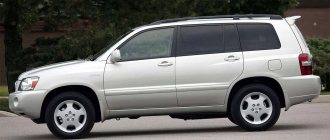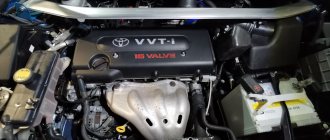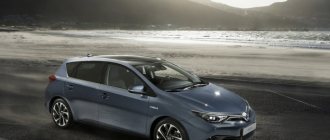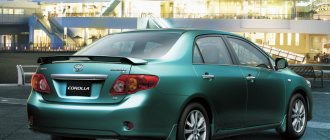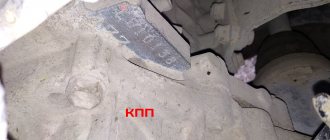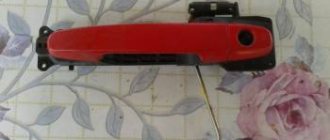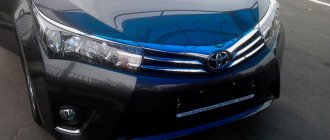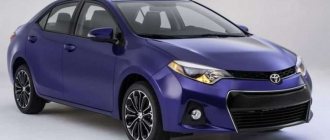The 2010 Toyota Corolla is one of the most popular golf sedan cars. This is a restyled modification of the 10th generation Corolla in the E150 body. Engineers modified the interior, body elements, and also added another engine. The model was produced until 2013, it was replaced by the 11th generation.
In the Russian Federation, 4 vehicle configurations with two engines were sold in showrooms. At one time, the cost of the poorest configuration was 642 thousand rubles, and the richest - 878 thousand. Today, you cannot find a new car like this in a showroom, but there are a lot of them on the secondary market, and at lower prices.
Exterior of Corolla 2010-2012
The appearance is attractive due to its rounded and smooth shapes. And solidity is given by modern optics and powerful bumpers. There are several features of the restyled model; the main differences from its predecessor can be identified:
- The radiator grille is divided into two halves, with the Toyota emblem in the middle.
- The front bumper has been changed, the size of the air intake has been increased.
- The car received new rear-view mirrors, they became elongated and turn signal repeaters were installed on them.
- In rich trim levels, updated R16 wheels with a pattern were installed.
- The taillights have a futuristic appearance, with transparent elements in the central part.
- The trunk lid has also changed, now it is divided into two halves by a chrome molding.
The restyled version of the Toyota Corolla 2010-12 fully corresponds in size to the C-class:
- Length – 4545 mm.
- Height – 1470 mm.
- Width – 1760 mm.
- Wheelbase – 2600 mm.
- Ground clearance – 150 mm.
Weight ranges from 1300-1380 kg, depending on the configuration.
Review of Toyota 1.6, 124 hp, 4 automatic transmission (2010)
Good afternoon!!!
Dedicating this small opus to those interested.
I sold my previous Corolla hatch in July, since the idea was long ago and the release of the new restyled one decided everything. By the way, I sold it to the first person who came to inspect it (I advertised it through this resource) for 420 thousand rubles.
So, I called the Rostov center, they say that in 2 weeks there will be a black and a red one on the machine in the penultimate configuration. I started calling all the salons in the Southern Federal District, found a gray one in stock in Volgograd (RUB 760), I book by phone, order a multilock, they do everything without any guarantees or prepayments on my part. The next day we come with my father (450 km) and pick it up, having purchased the original castings, mats (in the cabin and trunk) and go home. In general, the difference between the top-end and my configuration is 40 thousand rubles, which was not a problem for me, but the benefit is great, because for 40 t.r. you get orig. casting, bluetooth, cruise control, rain and light sensors, start button (keyless access)... and I only got the casting for 20... THAT'S IT... But I didn’t want to wait.
The road home is full and five thousand kilometers coasting along the highway at 90-120 km/h, everything is very good. good, the automatic machine works smoothly... BUT DOESN'T GO... I knew that this was how it should be. Therefore, I ran it in carefully, but did the first maintenance at 10 t.km. I tried to speed up, so to speak, and was a little disappointed. A little because I knew what I was getting into when I bought a 4-automatic transmission. In general, I went to Yeysk, the track is empty, without forcing it to roll up to 170 km/h, it seems to be good BUT... In general, compared to the previous one, it’s a little bad on the mechanics. Well, to hell with it, but it’s comfortable. On a straight road, far from smooth, it drives very well, my comrades also noted this (one has a new Focus 2L on an automatic, the other has a Civic 1.8 on a stick), very soft and at the same time knocked down, of course it floats in corners... but everything is relative.
Sound insulation is not bad, somewhere around 12 t.km. Something creaked in the area of the instrument panel, it was fixed under warranty, everything was fine. There is enough space in the front, decently wider than in the previous one, the seating position is the same. Visibility is impaired by wide A-pillars. Good light, both low beam (with halogens) and headlight. The ground clearance is very pleasing, although it is a little less than in the Hatch, and the overhangs are a little larger, but still. There's not much room in the back. In general, the appearance of the original gray casting is not bad at all.
Returning to the tandem of the engine and gearbox, I want to say that it is very good, but, in my opinion, the manual shift mode is not enough, only mode 3 saves (three gears are active, and in them it pulls up to 170 km/h), although this may be because this is my first car with an automatic transmission. The average consumption with active pedaling is a maximum of 11.7, with an adequate 8.5, I only pour LUKOIL 95-98 ecto (with a 5% discount))))
I would also like to especially note the brakes and the operation of the ABS system, the first snow fell today and it was possible to discover that it differs from the previous one in that, as it seemed to me, it allows for a short-term blocking of all wheels, the car begins to turn, but then this is interrupted and it levels out ( all this happens when the brake pedal is pressed to the limit). Maybe this is for the better, especially on dry surfaces and in the rain.
Well, these are the first impressions. I will answer any questions you may have.
Thank you for your attention.
Salon
Like any Japanese-made car, the interior is neat and of high quality. At the bottom, the steering wheel is slightly flattened, all instruments are covered with a small visor. At the bottom of the center console there is a narrowing on which the climate controls and the standard radio are located.
The front seats are comfortable, and there will be no fatigue when covering long distances. A large number of seat adjustments and good lateral support improve comfort. Three adults can easily fit in the back row.
Moreover, they will be comfortable, partly due to the fact that the 2010 Corolla does not have a central tunnel. Passengers in the second row do not have any amenities; there is only a folding armrest with cup holders.
Before you buy:
If you want to buy a 10th generation Toyota Corolla, you can safely look for such a car on the used car market, but only in good condition. Try to pay attention to the number of owners of this car. We do not recommend buying a car where the car had two owners (two owners) before you. This especially and directly applies to cars of the 2009 and 2010 models. Do not buy a car that the owner has not serviced at an authorized dealer or a full-fledged car service center. If such a car was serviced in a garage, then most likely this owner saved money, and not only on maintenance, but also on spare parts; he purchased mainly only non-original “consumables” (spare parts) for the car, which could well reduce the service life of the original factory spare parts. There is also a possibility that when servicing a car at a garage, its owner could purchase motor oil of questionable quality, which could also lead to premature wear of engine parts.
Before you buy a car, take it for a test drive, both on the highway and in the city.
Make sure that there are no errors on the dashboard and there is no indication, which usually warns of problems with airbags.
When driving a car, pay attention to the steering. Even if there are no problems with it (with it), the control itself in a Corolla car may not be to everyone’s liking.
Also, check the history of the car using the AutoCode system or using the online traffic police check, study the service book for the car, in which notes must be made about undergoing maintenance at an official dealer. At the same time, check the tires and the entire braking system. And finally, be sure to check the car at a car service center, having it (the car) undergo a comprehensive diagnostic of the engine, gearbox, electrics and the entire suspension.
Technical characteristics of Toyota Corolla 2010—2012
Toyota Corolla cars with two engines were sold in the Russian Federation:
- Volume 1.3 liters and power 101 hp. With. Works with a five-speed manual transmission, gasoline consumption is 4.9-5.8 liters. A very economical option - both the consumption is low and the transport tax is low. This motor was installed in the basic configuration, which was in wild demand.
- Volume 1.6 liters and power 124 hp. With. Works with mechanics and automatics. Gasoline consumption with a manual transmission is 5.8-6.9 liters. With an automatic transmission, consumption reaches 7.2 liters of gasoline per hundred.
The trunk is not very large - its volume is only 450 liters. But if you fold the rear seat backs, the volume approximately doubles. Under the raised floor there is a niche for storing a full-size spare wheel or a spare tire.
It is especially worth noting the level of safety of the car - according to NCAP standards, the model passed crash tests and scored all 5 stars out of a possible 5. The Elegance and more expensive ones, which have curtain airbags and knee airbags for the driver, are recognized as the safest configuration.
Read: Popular model Toyota Prado 1996-2002
Technical indicators
The 2010 Toyota Corolla boasted four-stroke, four-cylinder gasoline engines. Let's take a closer look at their technical characteristics.
1st type
An engine with a 1.33 liter V, equipped with the latest stop-start technology, this innovation made it possible to significantly reduce gasoline consumption and its costs:
- city – 7.3 l;
- driving on the highway - 4.9 l;
- mixed type of movement 5.8 l.
Such a powerful disassembly made it possible to obtain a maximum speed of 180 km/h, and accelerate to 100 km/h in 13.1 s.
2nd type
The 1.4 liter V engine, in principle, had the same characteristics as the above engine.
3rd type
A power unit with a 1.6 liter V in combination with an automatic transmission consumed:
- in urban conditions - 8 l;
- when driving on the highway – 6 l;
- in general driving mode – 7 liters.
A car equipped with such an engine, with a manual gearbox, reaches a top speed of 192 km/h, and accelerates to hundreds per hour in 10.5 seconds.
An automatic transmission uses more fuel:
- during city driving – 9.5 l;
- when driving on the highway - 6.1 l;
- in mixed mode - 7.3 l.
The maximum developed speed of the car is 183 km/h, the run from the start to the “hundredth” is 11.9 s.
In the Russian car market, the 2010 Toyota Corolla was presented with a manual and automatic transmission.
The suspension structure remains unchanged:
- front MacPherson struts;
- spring type rear struts.
The braking system is a guarantee of safety; all wheels are equipped with brake discs, even ventilated discs on the front ones.
Features of Toyota Corolla 2010-12 configurations
In total, 4 configurations could be found on the Russian market. “Comfort” included everything you need for convenience - central locking, radio, electric windows, headlight washers, immobilizer. The Elegance package included climate control (automatic), a multifunction steering wheel with audio system controls, and front fog lights.
The more expensive, the more prestigious the car. The top version is the “Prestige” version, in which all of the above was added with alloy wheels, various sensors (light, rain, parking sensors), as well as cruise control.
Corolla_08
The active and passive safety of the car remains the same:
anti-lock brake system (ABS)
electronic brake force distribution (EBD)
Brake Assist (BA)
- front airbags
- side airbags
- curtain airbags
- knee airbag for driver (depending on equipment)
- front seat belt warning system (with visual and audible alarm)
- safety pedal assembly
- safety steering column
- rear whiplash protection (WIL)
In addition, to protect the driver’s legs, the car is equipped with an injury-proof pedal assembly, and an injury-proof steering column, together with seat belts and airbags, protects the driver’s head and chest from injury. The front seats are designed to protect against whiplash injuries in rear-end collisions (WIL): the upper part of the seatback provides support for the upper back of the person, and the head restraint limits rearward movement of the head. This design is believed to minimize the risk of neck injury due to sudden rearward head movement in a low-speed collision.
The updated Toyota Corolla still comes in four main trim levels: Comfort, Comfort Plus, Elegance and Prestige.
Available in all trim levels: adjustable steering column for tilt and reach, heated and electrically adjustable side mirrors, folding rear row of seats 60:40, Optitron instrument panel lighting, fabric interior and heated front seats. AUX and USB ports are also now available in all trim levels. During the trip, a comfortable air temperature in the cabin is maintained by air conditioning or climate control (depending on the configuration). In the “Elegance” and “Prestige” trim levels, a multifunctional leather steering wheel in a new design and folding side mirrors are available. The “Prestige” package also offers: an electrochromic rear view mirror with a rear view camera, a Bluetooth function with the ability to control it from the steering wheel, light and rain sensors, cruise control and an intelligent system for accessing the car and starting the engine “Smart Entry & Push Start” "
The buyer has a choice of 8 body colors, 2 of which are offered for the first time - metallic blue and metallic red. Toyota Corolla is produced at a plant in Japan.
Prices for Toyota Corolla 2010 start at 599,000 rubles. For the “Comfort Plus” package - 647,000 rubles, "Elegance" - 749,000 rubles, "Prestige" from 799,000 rubles. Sales at dealerships will begin on July 1.
Toyota Corolla 2010, now in Russia
Reliability, quality and safety - the best solution for the money
Despite the fact that the 2009 and 2010 Toyota Corolla cars have good safety ratings based on NHTSA crash tests, it is still worth noting that in 2011, due to stricter testing requirements, 2011 cars received a much lower safety rating than in those past years. In this regard, starting from 2012, we modernized the rigidity of the body and increased the safety of our cars. For example, the 2012 car model withstands side impacts much better and better protects the driver and passengers.
For our part, we can recommend that if you have such an opportunity, then buy yourself better cars from 2012, which today are still more reliable and safer. It may be more expensive for you, but safety is more important than simply saving money. All errors, shortcomings and safety problems since the 2012 model range have been eliminated on the machine.
